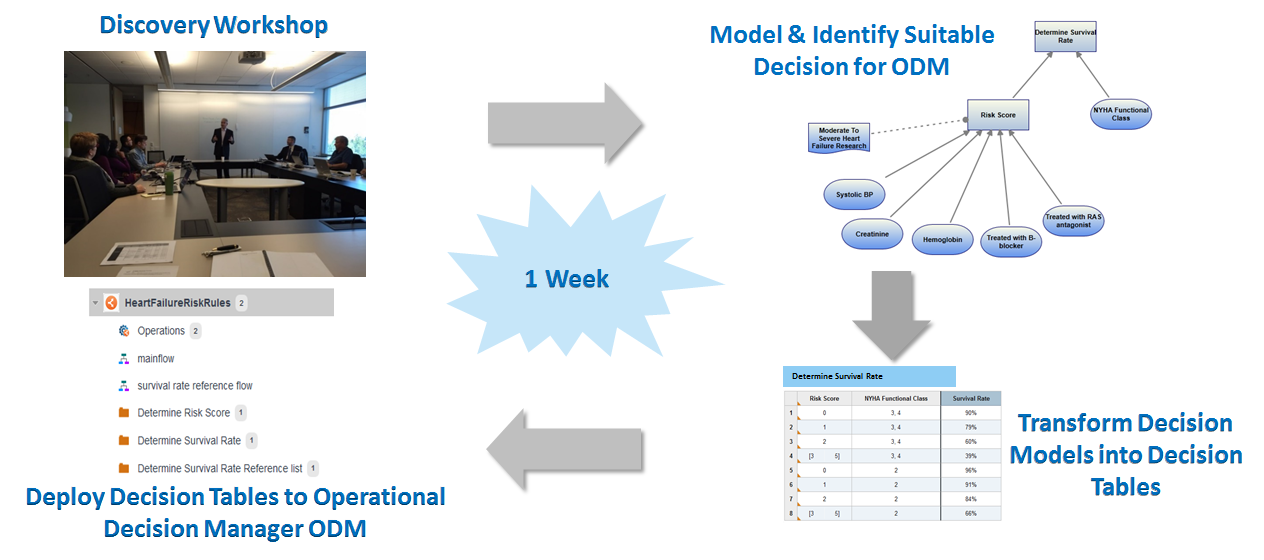Kaiser Permanente is developing Clinical Decision Support systems using a combination of Decision Modeling, DecisionsFirst Modeler and IBM’s Business Rules Management System ODM. Their experience is that well-designed decision services can replace existing guideline documents. This is critical as guideline documents are expensive to develop (they involve significant investment from SMEs) and even good guidelines are of limited use for real-time decision-making, especially if the decisions are fluid, specialized and complex. Kaiser Permanente is the nations largest not-for-profit health plan, providing care to over 11M members through 600+ locations and nearly 200,000 employees. As part of its IT infrastructure, Kaiser Permanente has deployed a Service Oriented Architecture infrastructure, a Business Process Management platform and now technologies for Decision Management.
At Interconnect 2017, Kaiser Permanente presented on its use of Decision Management, Decision Model and Notation (DMN) decision modeling, DecisionsFirst Modeler and IBM Operational Decision Manager (ODM) to develop these systems. Decision management in this case means more than just the use of IBM ODM – it means the systematic identification, automation and management of operational decisions to improve business results. This involves discovering and modeling the decisions that matter to their business, defining and implementing decision services – SOA components that make decisions – and then measuring and improving the quality of these decisions over time.
 For this project, the approach was applied to clinical decisions to see if it could be used to upgrade the approach and deliver evidence-based medicine. Today, evidence-based medicine revolves around the creation and use of documented clinical guidelines based on published research and best practices. But these are hard to manage and hard to use in practice. The new approach revolved a highly iterative decision-centric approach:
For this project, the approach was applied to clinical decisions to see if it could be used to upgrade the approach and deliver evidence-based medicine. Today, evidence-based medicine revolves around the creation and use of documented clinical guidelines based on published research and best practices. But these are hard to manage and hard to use in practice. The new approach revolved a highly iterative decision-centric approach:
- Decision Discovery workshop to identify and model key decisions, working with key subject matter experts (heart surgeons in this case)
- Decision modeling with DecisionsFirst Modeler to create decision requirements in DMN for the critical decisions based on medical evidence
- Transformation of decision models into simple, normalized, easy to manage decision tables and other business rules components in IBM ODM
- Deployment as a decision service on their SOA infrastructure
Once developed, these decision services can be accessed from multiple regional implementations, allowing for consistent application of evidence-based medicine. These decision services encapsulate the knowledge previously documented in many documents, mapping all that knowledge into a single, coherent decision model that can be automated as a decision service.Building these decision models also clarified data requirements, identifying data that was requested but not used and needed but not requested.
Guidelines are good but they are not scalable and do not support doctors in making better decision at the point of care. Replacing guidelines by modeling decisions and implementing them as decision services using IBM ODM will make it easier to build clinical decision support systems. This project demonstrated that:
Decision Modeling Workshops engage business owners, reveal automation boundaries and integrate multiple perspectives and documents
Decision Modeling supports iterative development, focuses BRMS development and simplifies /normalizes business rules
Decision Services can be developed this way that improve processes and this approach supports SOA best practices
